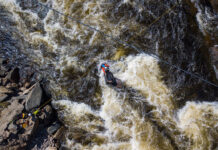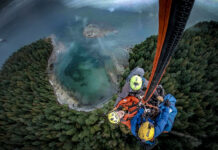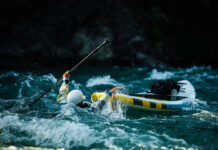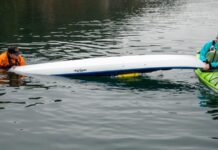On May 6, 2016, Bryan Orrio and Kelley McCallum bought two Old Town Trip 10 recreational kayaks from Dick’s Sporting Goods in Salem, Oregon. They headed for the Mehama run on the nearby North Santiam River, a stretch I know well.
Lots went wrong.
Orrio and McCallum claim the salesperson removed flotation foam from the bows, believing it was packing material. The two rec boats were on a class II whitewater run. The paddlers were inexperienced enough to refer to their paddles as “oars.”
Claiming injury from capsizing and wrestling the boats to shore, the pair sued Dick’s Sporting Goods for $455,000. Regardless of the outcome, the aquatic and legal kerfuffle is a warning about a possible future of kayaking. As paddling becomes increasing popular and mainstream, there will be more novices. Kayaks will be more readily available. But the water won’t get any more beginner or rec-boat friendly than it is now. The risks are apparent, and they raise old questions anew. What are the responsibilities of outfitters, paddlers and groups? What’s the right balance of safety and independence? When should we own it and admit we’re doofuses who got in over our heads?
When I descended the Grand Canyon, we asked the outfitter what skill level they required for renting their rafts. The answer? “A valid credit card.” They just rented equipment, and if we got into trouble or wrecked our gear, that was on us.
On the other hand, one local kayak shop I know won’t rent kayaks until the people have taken a basic class. I once arranged an out-of-town rental and was quizzed relentlessly about the rescue hierarchy. My local paddling clubs each have different takes on responsibility. One says that it’s the organizer’s job to get people to the put-in, but the participant’s responsibility to get down the river. Another asks the organizer to vet participants, assess conditions, skills and equipment, which can keep people from wanting to lead trips. Everyone has waivers. Nobody reads them.
Increasingly, kayaks are sold at big box retailers like Dick’s. Once the domain of specialist outfitters with in-depth knowledge of technique and waterways, buying a kayak can now be like buying a cordless drill at Home Depot or a car at the local dealership. It’s up to you not to put a hole in your thumb or drive into a tree.
But driving and drills are regulated. We test for driving licenses. Car safety is set by the National Highway Traffic Safety Administration and Transport Canada. There’s no test for the cordless drill, but novice craftspeople intuitively know not to put the drill against their hands. Novice paddlers don’t know to edge down current, or to edge at all. On that Mehama run, I’ve bailed out plenty of drunk summer floaters in inflatable pool toys and retrieved many a yard-sale beer cooler.
Nobody goes kayaking for the safety talks or regulations. We go to relish the freedom, self-reliance, and shared competence of navigating water that doesn’t care a whit about whether it’s safe for us or not. And when the same people who sell kayaks also sell softball bats, lacrosse sticks and soccer cleats, we’ll inevitably have salespeople who don’t know what kayaks are appropriate for class II or why there’s foam in the bow.
If folks are going to progress deeper into paddling, self-reliance and good judgment will help far more than rules and regulations.
These are the growing pains of kayaking’s success. If drills were only sold at a few boutique hardware stores in each city, we’d have a lot fewer people making cool stuff in their garages. We’re headed for a paddling community that is larger, and largely clueless. We could limit who can sell, buy, rent or paddle kayaks. We could ban boats without fore and aft bulkheads or float bags. We could up our game to educate everyone involved. We could do all three. Or we could accept capsizes as part of the learning process, a rite of passage like a kid’s scraped knees from the first bicycle crash without training wheels. Of course, when the kids in question are middle-aged and one’s the former County Deputy District Attorney—Orrio in this lawsuit—chances are we’ll have some lawsuits as well as stories at the pub afterward.
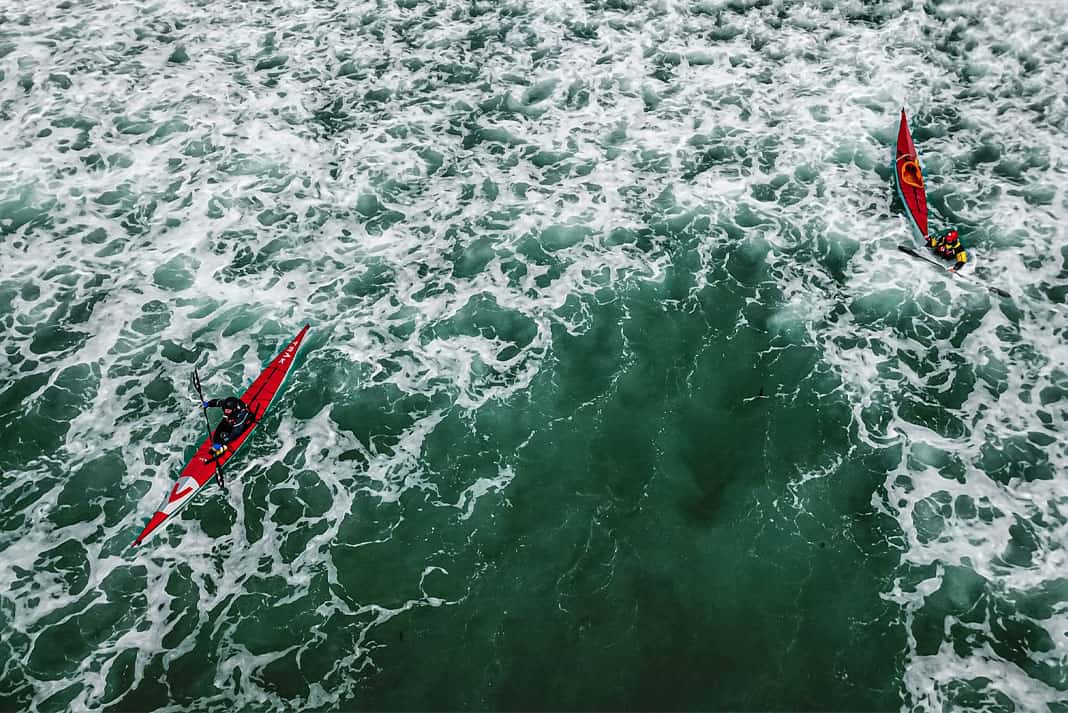
My bow points firmly toward education and self-reliance. Paddling is one of the last bastions of nature following its own rules. It’s survived like this from Inuit seal hunters, the advent of guided trips, helicopter parenting, and the Facebook era’s free-for-all social media groups. Climbing has the rock gym, skiing has lifts, grooming, and out-of-bounds rules. Kayaking, a few whitewater parks aside, is still just humans and the elements with no intermediaries. If folks are going to progress deeper into paddling, self-reliance and good judgment will help far more than rules and regulations. Yes, retailers should know the basics, like what flotation foam is for, and whether a recreational boat belongs on whitewater. And so should any buyer with a web browser.
Edward Abbey, one of my childhood heroes, wrote that the right to get lost, sunburnt, stranded or eaten by bears is the right and privilege of any free American. I haven’t been eaten by bears (yet), but my favorite childhood memories are paddling a canoe with just me and my sister or a childhood friend in the boat at the age of eight. And when things go downhill? As that venerable BCU five-star Jedi named Yoda once told a struggling two-star candidate named Luke Skywalker, “The greatest teacher, failure is.”
Or, as my friend Karl, who’s taller and doesn’t live on a swamp planet, says, “The environment is often the best teacher.” More drysuits, fewer lawsuits.
Neil Schulman loves the North Santiam River, especially the stretch from Packsaddle to Mill City, just a bit above the run in question. As of this writing, the lawsuit is awaiting discovery and a dispute resolution report.
Skills and rescue training is the best way to prevent an on-water accident. At a TRAK Kayak Surf Camp weekend in Ucluelet, British Columbia, paddlers learn to read the swell and recognize safe zones, which allows them to “enjoy and play in this area of the coast,” says photographer Jaime Sharp.
| Photo: Jamie Sharp



